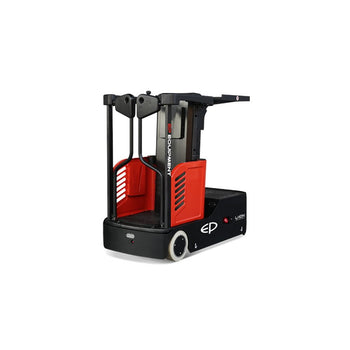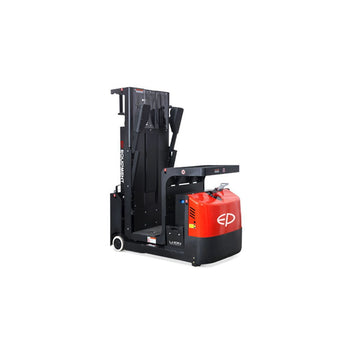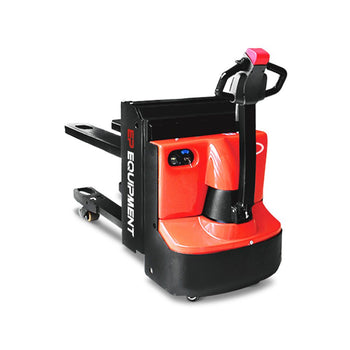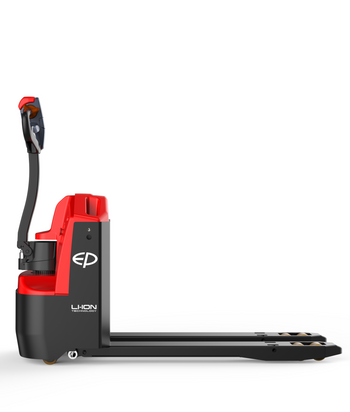Order picker forklifts – sometimes called stock pickers, order selectors or cherry pickers – are specialised pieces of material‑handling equipment designed to lift an operator to shelving and let them retrieve individual items by hand. In the formal forklift classification system they are Class II electric narrow‑aisle trucks, meaning they run on batteries and are designed to manoeuvre easily in tight warehouse aisles. Because they raise a worker to inventory rather than lifting pallets, they fill a different niche from counterbalance forklifts or reach trucks. This article introduces these machines, explains how they work, outlines the industries that rely on them and highlights why businesses like iLift provide order pickers as part of their material‑handling solutions.
Understanding Order Picker Forklifts
Order pickers look similar to small forklifts, but there are important differences. A typical unit consists of a compact chassis with a single powered drive wheel at the front and casters at the rear, an electric battery (usually 24, 36 or 48 volts) and hydraulic pumps to raise the platform. Behind the battery is the operator’s platform. Operators stand on this platform and use a steering wheel and joystick to drive forward or backward. When they reach the right shelf, they use controls on the platform to raise the platform along a mast to the desired height and pick items by hand. For safety, the platform has guardrails and a tie‑down point for a harness, and the machine will not operate unless a foot‑activated dead‑man pedal is depressed.
How They Work
An order picker’s small footprint and rear‑steer design allow it to turn sharply and navigate narrow aisles, something a conventional counterbalance forklift cannot do. The driver stands on the platform and uses a joystick to accelerate or reverse and a steering wheel to change direction. Built‑in controls lift or lower the platform so the operator can reach different rack levels. Because they are electric, order pickers produce no exhaust emissions and operate quietly, making them suitable for indoor use.
Types of Order Pickers
Warehouse layouts and order profiles vary, so manufacturers build several classes of order pickers to suit different applications:
-
Low‑level order pickers handle picking on ground and first‑tier shelves. These machines typically elevate the operator up to around 3 metres (10 feet) and allow frequent entry and exit. Some low‑level models can raise the platform only a metre (around 1 000 mm) to reach the first level, making them compact and fast.
-
Mid‑level order pickers are designed for medium‑height applications, usually 3–6 metres (10‑20 ft). They provide a good compromise between reach and manoeuvrability and are often used in small and medium‑sized warehouses.
-
High‑level order pickers can raise the platform over 9 metres (30 ft) and even up to 14 metres when using guided rails or wire guidance. These machines are built for high racking systems in large warehouses and often have enclosed cabs for operator safety.
-
Specialty order pickers serve niche tasks. For example, furniture pickers use long forks to handle bulky loads like couches and cabinets, while AGV (automated guided vehicle) order pickers can drive, tow and lift pallets autonomously.
Power Sources and Key Components
Most order pickers are battery‑powered. Lead‑acid batteries are common due to their reliability and relatively low cost, but they require regular maintenance. Lithium‑ion batteries are becoming popular because they offer higher energy density, faster charging and longer life, though they cost more. A few heavy‑duty order pickers use internal‑combustion engines (diesel, petrol or propane) for outdoor applications. Some low‑level models are manually propelled; operators push the unit between picks and use electric lift to raise the platform.
Key components include:
-
Mast and forks: The vertical mast lifts the platform and forks. Forks on order pickers often carry a small pallet or tote so items can be placed directly onto it.
-
Operator’s compartment: Contains the controls, dead‑man pedal and guardrails to protect the operator. Some high‑level models have enclosed cabs for comfort and safety.
-
Drive unit: A centrally‑located drive wheel provides propulsion and steering, while casters balance the rear.
-
Safety features: Standard equipment includes safety bars, parking brakes, warning lights and harness attachment points. More advanced models integrate operator‑presence sensors and automatic speed reduction when the platform is elevated.
Typical Uses and Industries
Order picker forklifts excel in warehousing and logistics, where they are used for stocking, picking, organising and unloading goods. Instead of pulling down an entire pallet to retrieve a single item, workers can raise themselves to the appropriate shelf and pick just the required product. This is particularly valuable when handling fragile or high‑mix inventory, as removing and restacking a full pallet increases the risk of damage.
Industries and facilities that commonly use order pickers include:
-
Warehouses and distribution centres: Order pickers are fundamental to warehouse operations. They allow quick access to inventory stored at various heights and are especially useful in facilities with narrow aisles and high racking.
-
Retail and wholesale: Retailers use order pickers to restock shelves and assemble store orders. In click‑and‑collect environments, staff use them to pull items from storage for customer pickup.
-
Fulfilment centres: E‑commerce operations rely heavily on order pickers to process online orders quickly and accurately. Fast, precise picking improves customer satisfaction and reduces shipping delays.
-
Manufacturing: Order pickers deliver components and materials to assembly lines and retrieve finished goods or spare parts.
-
Service centres and small packages: Hand‑pushed electric order pickers with 200 kg capacity and a 1.5 m lift are popular in service centres for small‑package despatch and low‑level picking.

Why Choose an Order Picker? Key Benefits
Order pickers offer several operational advantages:
-
Efficient use of space: Their ability to navigate narrow aisles and reach high storage locations allows businesses to maximise warehouse cubic capacity. This means more stock can be stored vertically rather than expanding floor space.
-
Increased productivity: Operators can drive, lift and pick in one seamless motion. Rapid travel and lift speeds minimise the time required to retrieve items, boosting pick rates and overall efficiency.
-
Improved accuracy and customer service: Picking individual products reduces errors associated with splitting pallets. Faster, more accurate order fulfilment leads to better customer satisfaction.
-
Versatility: Order pickers handle small to medium‑sized goods and operate at multiple heights, making them suitable for diverse industries such as retail, manufacturing and third‑party logistics.
-
Safety: Using an order picker is generally safer than climbing ladders. Machines incorporate safety bars, harness points and parking brakes. Standing platforms provide secure footing, and some models have operator‑presence sensors to reduce speed when elevated.
Safety and Training
Safety is paramount when operating order pickers. Key guidelines include:
-
Proper training: Operators must receive comprehensive training on controls, safe operation, loading and navigation.
-
Regular maintenance: Daily inspections and scheduled servicing ensure brakes, steering and lift mechanisms are functioning correctly.
-
Safe speeds: Always drive at safe speeds, especially when the platform is raised. Many models automatically limit travel speed when elevated.
-
Correct loading: Never exceed the manufacturer’s weight limit and ensure loads are evenly distributed.
-
Personal protective equipment: Depending on the environment, operators should wear high‑visibility clothing, safety shoes and use fall‑protection harnesses.
-
Stay alert: Operators must remain aware of other workers, obstacles and safety signage.
Following these guidelines minimises accidents and protects both workers and goods.
Price Considerations and Budgeting
The cost of an order picker depends on its complexity, capacity and features. Low‑level electric order pickers designed for small packages can cost about £2,860; for example, an electric order picker with a 200 kg capacity and 1.5 m lift is priced at £2,859.75. These compact units are hand‑pushed between picks and are ideal for light‑duty despatch tasks.
For full‑size forklifts, prices vary widely. a basic forklift costs £9,000–£22,000, while models with specialised features can reach £35,000–£75,000. Electric forklifts typically range from £11,000–£18,000 and propane‑powered models £14,000–£22,000. Order pickers fall within this spectrum: low‑level units are closer to the bottom end, whereas high‑level, guided models with enclosed cabs and sophisticated control systems can cost tens of thousands of pounds. Factors influencing price include lift height, load capacity, battery technology, guidance systems and optional attachments.
Buying new equipment isn’t the only option; businesses can also consider ex‑demo units or rental to lower upfront costs. iLift, for instance, offers special deals on ex‑demo lithium forklifts and flexible rental plans, making it easier for organisations to access modern equipment without a large capital outlay.
Choosing the Right Order Picker
Selecting the appropriate order picker requires careful analysis of your operation:
-
Define your requirements. Identify the types of products you’ll be picking, their weight and the height of your storage racks.
-
Check load capacity and lift height. Make sure the machine’s maximum lift height reaches your highest shelf and that its load capacity matches the heaviest items.
-
Consider aisle width and floor conditions. Narrow aisles favour compact, rear‑steer order pickers; uneven floors or outdoor areas may require machines with pneumatic tyres.
-
Evaluate battery life and charging. Continuous, multi‑shift operations benefit from lithium‑ion batteries because they charge faster and last longer.
-
Review safety features. Look for anti‑slip platforms, harness points, automatic speed reduction and integrated diagnostics.
-
Balance price and value. While it’s tempting to choose the cheapest option, investing in the right machine can yield significant productivity gains and lower total cost of ownership.
Consulting with a trusted supplier helps match equipment to your specific needs. Manufacturers and dealers often provide site surveys to recommend appropriate models and may assist in optimising racking layouts and workflows.
Who Needs an Order Picker?
You may need an order picker if your operation involves:
-
Picking individual items rather than entire pallets. Pulling down a whole pallet just to retrieve one product is inefficient and risks product damage.
-
High SKU variety and small‑quantity orders, such as e‑commerce fulfilment or parts distribution. Order pickers speed up single‑item picks and reduce order cycle times.
-
Narrow aisles and high racks. Facilities using very narrow aisle (VNA) layouts or high bay racking rely on order pickers to access upper levels safely.
-
Improved safety requirements, where ladders or step‑stools pose fall risks. Order pickers provide stable platforms, guardrails and integrated braking systems.
If your business regularly stocks, organises and retrieves items at multiple levels, an order picker can drastically improve efficiency and reduce strain on staff.

Explore iLift’s Order Pickers and Material‑Handling Solutions
iLift specialises in lithium‑ion forklift trucks, pallet trucks, stackers, order pickers and reach trucks. Their electric order picker range includes the JX0 and JX1 models, which are compact machines designed for efficient order picking. The company prides itself on modern lithium‑ion technology, pre‑delivery inspections, flexible service contracts and a five‑year battery warranty, ensuring every machine arrives ready for work.
Beyond order pickers, iLift offers a complete line of electric pallet trucks such as the EPL154/185 and the EPT WA Series. These trucks leverage lithium batteries and durable motors to handle weights from 1 500 kg to 2 500 kg, making them perfect companions to order pickers for moving pallets between storage and shipping areas. iLift’s focus on sustainable battery technology and customer support – including free delivery across the UK and the option to reserve equipment for a small deposit – makes it an attractive partner for businesses upgrading their warehouse equipment.
Ready to improve your order‑picking efficiency?
Explore iLift’s range of electric order pickers and pallet trucks on their website. The JX0 and JX1 order pickers combine compact design with lithium‑ion power, and iLift’s pallet trucks offer reliable material‑handling solutions for every application. Whether you’re seeking to buy new equipment, find an ex‑demo deal or rent a fleet, iLift’s experts can guide you toward the right solution. Visit iLift to see the full range and request a personalised quotation today.





